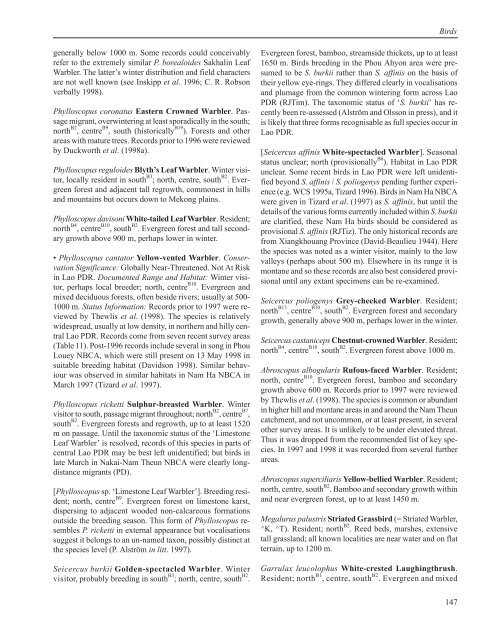Wildlife of Lao PDR: 1999 Status Report - IUCN
Wildlife of Lao PDR: 1999 Status Report - IUCN
Wildlife of Lao PDR: 1999 Status Report - IUCN
You also want an ePaper? Increase the reach of your titles
YUMPU automatically turns print PDFs into web optimized ePapers that Google loves.
generally below 1000 m. Some records could conceivably<br />
refer to the extremely similar P. borealoides Sakhalin Leaf<br />
Warbler. The latter’s winter distribution and field characters<br />
are not well known (see Inskipp et al. 1996; C. R. Robson<br />
verbally 1998).<br />
Phylloscopus coronatus Eastern Crowned Warbler. Passage<br />
migrant, overwintering at least sporadically in the south;<br />
north B2 , centre B9 , south (historically B19 ). Forests and other<br />
areas with mature trees. Records prior to 1996 were reviewed<br />
by Duckworth et al. (1998a).<br />
Phylloscopus reguloides Blyth’s Leaf Warbler. Winter visitor,<br />
locally resident in south B3 ; north, centre, south B2 . Evergreen<br />
forest and adjacent tall regrowth, commonest in hills<br />
and mountains but occurs down to Mekong plains.<br />
Phylloscopus davisoni White-tailed Leaf Warbler. Resident;<br />
north B4 , centre B10 , south B2 . Evergreen forest and tall secondary<br />
growth above 900 m, perhaps lower in winter.<br />
• Phylloscopus cantator Yellow-vented Warbler. Conservation<br />
Significance: Globally Near-Threatened. Not At Risk<br />
in <strong>Lao</strong> <strong>PDR</strong>. Documented Range and Habitat: Winter visitor,<br />
perhaps local breeder; north, centre B10 . Evergreen and<br />
mixed deciduous forests, <strong>of</strong>ten beside rivers; usually at 500-<br />
1000 m. <strong>Status</strong> Information: Records prior to 1997 were reviewed<br />
by Thewlis et al. (1998). The species is relatively<br />
widespread, usually at low density, in northern and hilly central<br />
<strong>Lao</strong> <strong>PDR</strong>. Records come from seven recent survey areas<br />
(Table 11). Post-1996 records include several in song in Phou<br />
Louey NBCA, which were still present on 13 May 1998 in<br />
suitable breeding habitat (Davidson 1998). Similar behaviour<br />
was observed in similar habitats in Nam Ha NBCA in<br />
March 1997 (Tizard et al. 1997).<br />
Phylloscopus ricketti Sulphur-breasted Warbler. Winter<br />
visitor to south, passage migrant throughout; north B2 , centre B7 ,<br />
south B2 . Evergreen forests and regrowth, up to at least 1520<br />
m on passage. Until the taxonomic status <strong>of</strong> the ‘Limestone<br />
Leaf Warbler’ is resolved, records <strong>of</strong> this species in parts <strong>of</strong><br />
central <strong>Lao</strong> <strong>PDR</strong> may be best left unidentified; but birds in<br />
late March in Nakai-Nam Theun NBCA were clearly longdistance<br />
migrants (PD).<br />
[Phylloscopus sp. ‘Limestone Leaf Warbler’]. Breeding resident;<br />
north, centre B9 . Evergreen forest on limestone karst,<br />
dispersing to adjacent wooded non-calcareous formations<br />
outside the breeding season. This form <strong>of</strong> Phylloscopus resembles<br />
P. ricketti in external appearance but vocalisations<br />
suggest it belongs to an un-named taxon, possibly distinct at<br />
the species level (P. Alström in litt. 1997).<br />
Seicercus burkii Golden-spectacled Warbler. Winter<br />
visitor, probably breeding in south B3 ; north, centre, south B2 .<br />
Birds<br />
Evergreen forest, bamboo, streamside thickets, up to at least<br />
1650 m. Birds breeding in the Phou Ahyon area were presumed<br />
to be S. burkii rather than S. affinis on the basis <strong>of</strong><br />
their yellow eye-rings. They differed clearly in vocalisations<br />
and plumage from the common wintering form across <strong>Lao</strong><br />
<strong>PDR</strong> (RJTim). The taxonomic status <strong>of</strong> ‘S. burkii’ has recently<br />
been re-assessed (Alström and Olsson in press), and it<br />
is likely that three forms recognisable as full species occur in<br />
<strong>Lao</strong> <strong>PDR</strong>.<br />
[Seicercus affinis White-spectacled Warbler]. Seasonal<br />
status unclear; north (provisionally B6 ). Habitat in <strong>Lao</strong> <strong>PDR</strong><br />
unclear. Some recent birds in <strong>Lao</strong> <strong>PDR</strong> were left unidentified<br />
beyond S. affinis / S. poliogenys pending further experience<br />
(e.g. WCS 1995a, Tizard 1996). Birds in Nam Ha NBCA<br />
were given in Tizard et al. (1997) as S. affinis, but until the<br />
details <strong>of</strong> the various forms currently included within S. burkii<br />
are clarified, these Nam Ha birds should be considered as<br />
provisional S. affinis (RJTiz). The only historical records are<br />
from Xiangkhouang Province (David-Beaulieu 1944). Here<br />
the species was noted as a winter visitor, mainly to the low<br />
valleys (perhaps about 500 m). Elsewhere in its range it is<br />
montane and so these records are also best considered provisional<br />
until any extant specimens can be re-examined.<br />
Seicercus poliogenys Grey-cheeked Warbler. Resident;<br />
north B13 , centre B10 , south B2 . Evergreen forest and secondary<br />
growth, generally above 900 m, perhaps lower in the winter.<br />
Seicercus castaniceps Chestnut-crowned Warbler. Resident;<br />
north B4 , centre B10 , south B2 . Evergreen forest above 1000 m.<br />
Abroscopus albogularis Rufous-faced Warbler. Resident;<br />
north, centre B10 . Evergreen forest, bamboo and secondary<br />
growth above 600 m. Records prior to 1997 were reviewed<br />
by Thewlis et al. (1998). The species is common or abundant<br />
in higher hill and montane areas in and around the Nam Theun<br />
catchment, and not uncommon, or at least present, in several<br />
other survey areas. It is unlikely to be under elevated threat.<br />
Thus it was dropped from the recommended list <strong>of</strong> key species.<br />
In 1997 and 1998 it was recorded from several further<br />
areas.<br />
Abroscopus superciliaris Yellow-bellied Warbler. Resident;<br />
north, centre, south B2 . Bamboo and secondary growth within<br />
and near evergreen forest, up to at least 1450 m.<br />
Megalurus palustris Striated Grassbird (= Striated Warbler,<br />
^K, ^T). Resident; north B2 . Reed beds, marshes, extensive<br />
tall grassland; all known localities are near water and on flat<br />
terrain, up to 1200 m.<br />
Garrulax leucolophus White-crested Laughingthrush.<br />
Resident; north B1 , centre, south B2 . Evergreen and mixed<br />
147

















